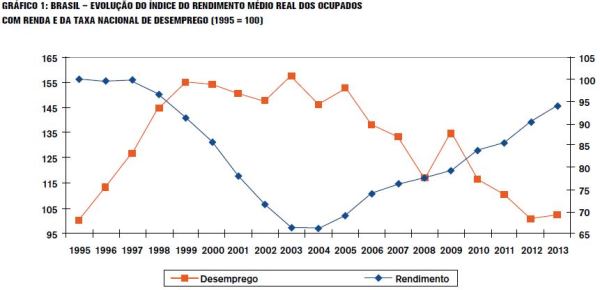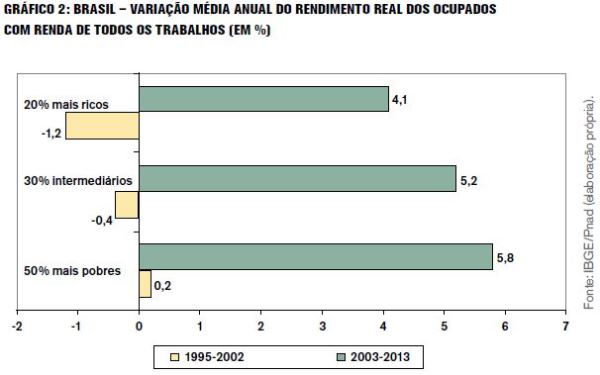The partnership between Brasil Wire and LeMonde Diplomatique Brasil continues with our second shared article, by Dr. Marcio Pochmann, one of Brasil’s most important developmentalist economists.
The filters that uphold Brazil’s meritocracy are expressed in social monopolies through education, recommendation networks and relationship circles. Public policies for inclusion are challenging them on several levels, revealing people in the higher income bracket’s incapacity to deal with competition.
By Marcio Pochmann
The foundation of Brazilian society was built on inequality. Colonization was originally developed to generate and sustain wealth through the use of slave labor. These social relationship parameters fostered a generalized culture of inequality as a basic condition for national unity.
As the 19th Century came to a close, savage capitalism blocked all possible attempts at agrarian, tributary and social reform. Inequality proliferated even further, aligning with wealth progression. The transformation from agrarian to urban, industrial society occurred with no minimum standards for individual competition with a unique combination of the old and the new.
The coexistence of an archaic rural structure with industrial modernity limited advances in social and labor protection (such as the consolidated labor laws of 1943) to the minority percentage of workers who lived in cities. Conservative forces have remained intact ever since, perpetrating contradictions such as the fact that plantation and ranching interests control the largest caucus (the ruralistas) within the current federal legislature in a country where 86% of the population live in cities.
The privileged class’ exclusive individual access to meritocratic competition resists through the vigor of state cronyism, which continues to build and sustain the social monopolies that have historically guaranteed differentiated socioeconomic ascension. The funnel of education shows how segments with less purchasing power are disconnected from the vigor of social, economic and political mobility.
The 100-year delay to guarantee universal access to elementary school education (for children up to 14) between the founding of the Republic (1889) and the Federal Constitution of 1988 demonstrates how education produces and reproduces inequality. A higher education system that serves less than 15% of the youth between the ages of 18-24 continues to compromise the ideal of justice through an unequal distribution of opportunities. Furthermore, the exorbitant difference in quality continues to deeply contaminate the national education system.
In synthesis, Brazil, which built a significant trajectory of economic expansion over time that enabled it to sit among the wealthiest economies in the world, also became a reference in inequality and one of the most unequal countries on the planet. (1)
The unprecedented experience that started in the 2000s, combining a democratic regime with economic growth and inequality reduction, generated both satisfaction and discomfort within Brazilian society. After half a millennium of unequal social construction it would be naive to believe that its initial reduction would only be met with support and satisfaction.
The growing opposition is uncomfortable with the recent experience of inequality reduction and, above all, with the possibility that this process will stay active in the near future. The new impasse in the heart of Brazilian society appears to be caused by the satisfaction of those who rose faster and don’t want to interrupt this trajectory and the rest of society’s discomfort with the growing reduction of inequality.
It has not been easy to understand this this scenario although its consequences appear to be clear in terms of the growing political polarization. The following three sections of this article aim to contribute to the current debate on the identifiable causes of satisfaction and discomfort in Brazilian society.
Changes in inequality patterns
Brazil underwent two distinct periods in distributive standards since monetarist stability was established through the Real Plan during the Itamar Franco government in 1994. The first occurred between 1995 and 2003, when few social classes improved their relative participation in income and work.

Translation: Desemprego = Unemployment, Rendimento = Income.
Table 1 shows that median income purchasing power remained stable between 1995 and 1997. After this, inflation-controlled median income levels steadily declined until 2003. Furthermore unemployment increased steadily between 1995 and 1999, then remained stable until 2005.
Distributive gains began to improve in practically all social segments in 2004. National unemployment levels declined, median income purchasing power and living conditions for the entire population increased.
The change in distribution patterns during the period of monetary stability can be better described by separating Brazilian society into three distinct segments by income level (rich, intermediate and poor) as seen on table 2. Between 1995 and 2002 Brazilians with intermediate income levels (between the 6th and 8th tenth in personal income distribution) registered an annual, inflation controlled loss of .4% while the 20% wealthiest segment suffered a larger annual income loss (1.2%). Only the 50% of the population classified as poor were able to maintain income levels above inflation, with an annual average increase of 0.2%.

Translation: Mais Ricos = Most Wealthy, Intermediarios = Intermediate, Mais Pobres = Most Poor
All social segments significantly increased their income levels during the period between 2003 and 2013. Income for the poor increased an average of 5.8% per year. The intermediate sector had an average annual income increase of 5.2% while yearly income for the rich rose by an average of 4.1%.
Differentiated reactions to distributive changes
A simple increase in material wealth patterns, although important, does not satisfy the individual and collective needs of a determined country.
Studies show that the absolute rise in living standards appears generally sufficient to increase satisfaction levels among the poor (2).
The same tendency, however, does not appear to increase the individual satisfaction levels for those who are located in higher income segments. This is because the absolute increase in living standards for individuals in the middle and upper classes is not necessarily capable of influencing their satisfaction levels. In their case individual satisfaction is more related to personal, material living standard improvement compared to other individuals in society. Rising individual living standards are compared to those of other segments- if they are superior the level of personal satisfaction tends to be greater. The fact that the improvement in the rich and middle classes’ individual living standards occurs at a lower rate than the evolution of the society as a whole can cause dissatisfaction.
An increase in living standards in a society where inequality decreases presupposes that the lower income segments rise quicker than the rest of the population. This can produce a greater level of satisfaction concentrated among low income individuals. The wealthier segments, however, can develop dissatisfaction based on the fact that their living standard grew less than those of the poor.
On the other hand, a society where inequality increases tends to satisfy the highest income segment, who’s standard of living increases quicker than the poor. In this situation, dissatisfaction does not necessarily present itself among the poor.
This satisfaction paradox can shed light on the discomfort that members of higher income segments show with the vigorous inclusion policies that have been implemented since 2003. In a general manner the relationship between voter satisfaction and socioeconomic and territorial dimensions greatly exacerbated during the 2000s.
Wealthier individuals and states tend to present growing dissatisfaction with policies designed to raise everyone’s material living standards, most importantly for the poorer segments of the population. In the beginning of the 2000s material living standards rose in a generalized manner. However, since this improvement was more concentrated among the poor the inequality levels improved. This generates different levels of satisfaction and dissatisfaction within the population.
In short, not everyone supports the struggle against inequality. It depends on what segment of the population the individual belongs to, as well as the absolute and relative increase in individual living standards. Without this knowledge its hard to understand Brazil’s current satisfaction paradox.
Thoughts for consideration
These days there are more and more studies on the relationship between societies’ infra and superstructures. With this it is becoming more important to understand the connections between the effects of economic behavior on the material base with feelings and actions that express themselves through cultural and political movements (3).
In general, the economics-based modifications of society end up pushing, at a greater or lesser level, simultaneous effects on society’s superstructure. They cause changes and consequences along time, and their determinations should not be ignored.
This point can contribute to understanding Brazil’s current political context. According to the public opinion study done by the Perseu Abramo Foundation (Manifestações de Março/2015) (4) with representative samples of participants of the March 13 and March 15 protests, the impacts of the transformation on the material base and people’s feelings have become evident – for better or for worse.
The average profile of those who came to the streets to protest on March 13 was closer to the national average, with the important presence of people of color and with lower incomes. These sectors were impacted substantially by relative changes in the economy during the 2000s and the general increase in employment levels, formal employment, increased purchasing power, generalization of access to credit and greater, more diversified consumption.
On the other hand, the average participant in the March 15 protests was farther from the typical Brazilian characteristics due to greater education level, income and race/color. For these social segments, The economic changes impacted these social segments them less positively or brought consequences that they perceive as negative.
Even though the ascension of those “from below” did not have negative repercussions on the wealthiest Brazilians’ living standards, it generated a certain level of discomfort through the reduction of the distance that, until recently, marked the space of action of the different social classes and class fractions. In a certain way you can even see signs that the wealthiest segments feel threatened by the process of fighting exclusion of the poor because of increased competition for opportunities.
The filters that uphold Brazil’s meritocracy are expressed in social monopolies through education, recommendation networks and relationship circles. Public policies for inclusion are challenging them on several levels, revealing people in the higher income bracket’s incapacity to deal with competition. In fact, the democratization of access to high school and university, of greater consumption value units and of entertainment, among others, has made it more difficult for the children of those who are already included to continue calmly enrolling in the top level universities, the highest paid jobs, etc, because there are more and more competitors.
With this, the recent protests in Brazil seem to indicate two distinct feelings. On the one hand, the feeling of those who don’t want any interruption in the channels of socioeconomic ascension established in the 2000s because of the current low level of economic dynamism, the weakening of top quality job-generation and the rising price levels compared to purchasing power.
On the other hand are the feelings of those who favor blocking the lower classes’ social ascension mechanisms who support public spending cuts and moral posturing to limit the greater potential of those who come “from below”.
1 Essa perspectiva encontra-se desenvolvida em Marcio Pochmann, Desigualdade econômica no Brasil, Saber Livros, São Paulo, 2015.
2 Para mais detalhes, ver Paul David e Melvin Reder, Nations and Household in Economic Growth[Nações e famílias no crescimento econômico], Academic Press, Nova York, 1974; e Betsey Stevenson e Justin Wolfers, “Economic Growth and Subjective Well-Being” [Crescimento econômico e bem-estar subjetivo], NBER Working Papers n.14.282, 2008.
3 Para mais detalhes, ver Marcio Pochmann, A vez dos intocáveis, FPA, São Paulo, 2014.
4 Ver em: http://novo.fpabramo.org.br/content/fpa-lanca-pesquisa-com-perfil-dos-manifestantes-de-marco-de-2015.

